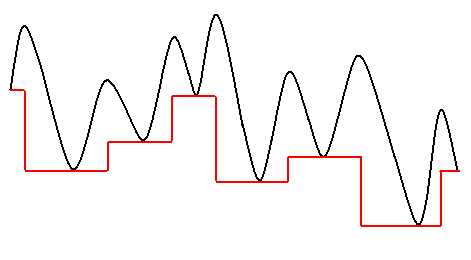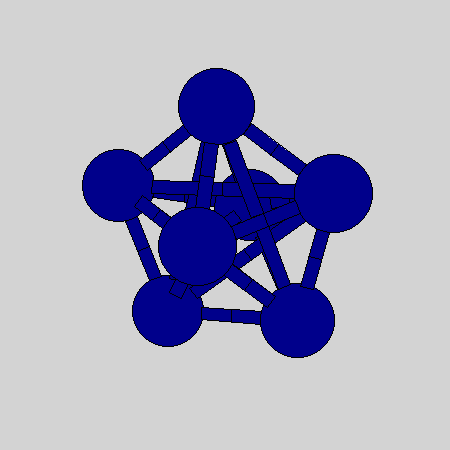NCSA Nanotechnology InitiativeDeveloping and porting code to run on NT and LINUX pentium clustersGMINThe GMIN1 global minimization code from Wales' group at Cambridge University, has been parallelized using MPI directives and used for large benchmark calculations on the NT cluster and SGI Origin at NCSA, and on an IBM RS6000 cluster at the University of Pittsburgh. The code is also being ported to the Pentium Beowulf cluster at the Albuquerque High Performance Computing Center. This algorithm uses a Monte Carlo "search" to explore configuration space together with an energy minimization which transforms the potential energy surface (PES) and effectively removes transition state regions.1 The diagram below illustrates how GMIN may change a PES (black) into a modified "terrace" potential (red). Unlike many other surface deformation methods, GMIN leaves the global and local minima unchanged. The transformation increases the probability of escaping from local minima and facilitates locating the global minimum. 
More details on the GMIN algorithm and a brief summary of some of the systems to which it has been applied may be found here. Availability of the GMIN codeA scalar version of the GMIN code is available from Wales' website at Cambridge University. A parallel version has been developed as part of the Nanotechnology Initiative by extending the functionality of Wales' code. The publically released versions of the serial and parallel GMIN codes have built in Lennard-Jones and Morse potentials. Information on accessing the parallel version of GMIN will be provided in the near future. If you are interested in using the parallel version of this code please contact: Lindsey J. Munro. Documentation on the parallel version of GMIN
Investigation of binary Lennard-Jones clusters
We are presently using the GMIN algorithm to locate the global minima of large
mixed Ar-Xe, Ar-Ne and Ar-Kr clusters. Particular emphasis is being placed on clusters containing
38 and 75-77 atoms which have proven to be especially challenging for the "unmixed" Ar clusters and,
as a contrast, 55-atom clusters, which has been found to be more straightforward
for the pure Ar55 cluster. The animation to the left shows the global minima of
ArnXem clusters, where n+m=7, and illustrating the
substitution pattern for the Xenon atoms.
The blue and green atoms represent Argon and Xenon respectively. (It may be necessary to press Reload
to view the animation.)
Future work
|
Dept. of Chemistry, University of Pittsburgh,
219 Parkman Avenue, Pittsburgh, PA 15260
Phone: (412) 624-8690 FAX: (412) 624-8611 email: jordan at pitt.edu
This page last updated: